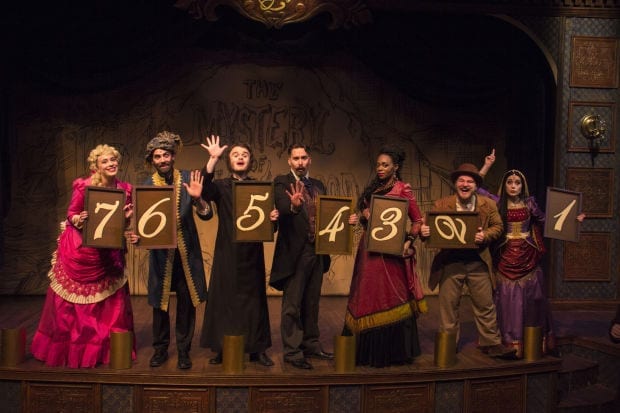SALT LAKE CITY — With Wait! Julie Jensen has created a love letter to theatre and the misfits who inhabit it. The coming of age tale surrounding Wendy Burger and the collection of odd ducks that share in her coming-of-age story embodies the traits and tropes of those who have found themselves made better by a love affair with building fictional worlds and speaking lines written by others. Wendy, our heroine, begins as a plucky, if untethered, soul who seems to float through her life as disembodied as a ghost light on an empty stage. Sydney Shoell inhabits Wendy with whole-hearted positivity, kindness, and modest wonder. Speaking directly to the audience, Wendy tells her own story and seems taken aback by the growth and success that comes her way, seemingly unaware that it is all brought on by her own power, determination, and kindheartedness. Raised in a hick-town and impoverished circumstances where no one would expect much from her, Wendy seems to have inner reserves of strength and positivity that keep her going. She holds a steady job, earns her own apartment, volunteers her time to help her friend, and it would seem, when not confiding in the audience, spends her free time committing classic speeches to memory. Wendy seems taken aback by her own success, and while this is endearing, it is also a bit inexplicable. That pause frames the foundation of the few hesitations I felt while encountering this story.
 I can have no reservations about the acting or design choices of the Pygmalion‘s production. Each actor is a delight individually and as they work together. Especially enjoyable are Tamara Howell and Mark Brocksmith in a range of roles that support and challenge Shoell as Wendy who carries the bulk of the script and momentum of the story. As a kind but socially anxious soul, Wendy is perpetually taken for granted by everyone in her life. While her father loves her, his alcoholism and shifting romantic entanglements always seems to take prominence in his life. Wendy is all but forgotten by former teachers and classmates alike and is taken advantage of by her best friend Lou. Brocksmith plays the rival roles of Wendy’s father and Wendy’s best friend with equal charisma but is admirably divergent in physicality and vocalization. Tamara Howell brings zesty joy to each of her characters. I especially enjoyed her as the grand-dame art teacher, Ms. Floating Pinata Head. In the scene where she takes Wendy on a deep dive lesson on performing Shakespeare, I found myself holding up the bard’s famous mirror of nature, having personally enacted this scene countless times as a young actor discovering Shakespeare for the first time. Daisy Blake Perry is charming as the vapid yet devout young starlet, Oh Vixen My Vixen. Her bouncy self-assurance and endless chatter turn Wendy’s head with an unexpected, heart-pounding crush.
I can have no reservations about the acting or design choices of the Pygmalion‘s production. Each actor is a delight individually and as they work together. Especially enjoyable are Tamara Howell and Mark Brocksmith in a range of roles that support and challenge Shoell as Wendy who carries the bulk of the script and momentum of the story. As a kind but socially anxious soul, Wendy is perpetually taken for granted by everyone in her life. While her father loves her, his alcoholism and shifting romantic entanglements always seems to take prominence in his life. Wendy is all but forgotten by former teachers and classmates alike and is taken advantage of by her best friend Lou. Brocksmith plays the rival roles of Wendy’s father and Wendy’s best friend with equal charisma but is admirably divergent in physicality and vocalization. Tamara Howell brings zesty joy to each of her characters. I especially enjoyed her as the grand-dame art teacher, Ms. Floating Pinata Head. In the scene where she takes Wendy on a deep dive lesson on performing Shakespeare, I found myself holding up the bard’s famous mirror of nature, having personally enacted this scene countless times as a young actor discovering Shakespeare for the first time. Daisy Blake Perry is charming as the vapid yet devout young starlet, Oh Vixen My Vixen. Her bouncy self-assurance and endless chatter turn Wendy’s head with an unexpected, heart-pounding crush.
Equally impressive and seemingly effortless is the set design by Thomas George. An elaborate but unfinished wooden proscenium arch provides an excellent outline of a decrepit old opera house Wendy is working to restore with little more than dreams and elbow grease. Though the remainder of the set, at first sight little more than a collection of junk, a mish-mash of storage that is prone to gather in the wings of an abandoned theatre, its pieces deftly become the furnishing of the various other playing spaces. As the action progresses and the rundown opera house approaches its grand reopening, the junk is reborn. Covered in elegant red drapery, the re-purposed junk becomes a theatrical space. Similarly, Wendy rearranges the elements of her own life to create new purpose and meaning. Maddiey Howell’s costume design slowly peels back the layers that Wendy seems to have shrouded herself in, and as she physically begins to take on shape and dimension, she develops a more solid form of herself. Her emotional growth allows her true frame to be seen for the first time. Rachael Harned’s lighting leaves nothing to be desired, and while the volume of Mikal Troy Klee’s soundscape is at times uneven, it is cleverly scored with sound effects and the romantic songs of the 1950’s movies that so enthrall Wendy.
Though the high quality of the acting and production, including clear and clever direction by Pyg’s artistic director, Fran Pruyn, left me delighted, on the whole Jensen’s story left me somewhat bewildered. Small hiccups found in occasional moments in the play brought me out of the action and into unnecessary questions about the setting. The actors spoke with clear southern accents, and there were many indicators that the play was set in the American south sometime in the last 50 years; however, sudden references to the Angel Moroni and Salt Lake City, which would earn an easy laugh from a cheerful local audience, only confused me. More broadly, while the story flowed nicely toward its resolution and appropriate character growth, I couldn’t decipher a larger message or theme for the story. Even the title itself, though referenced at least once in the script, left me unclear about its meaning in relation to Wendy. Despite these issues, Wait! is still an enjoyable performance and a unique treat for those lucky enough to have been bitten by the theatre bug.




